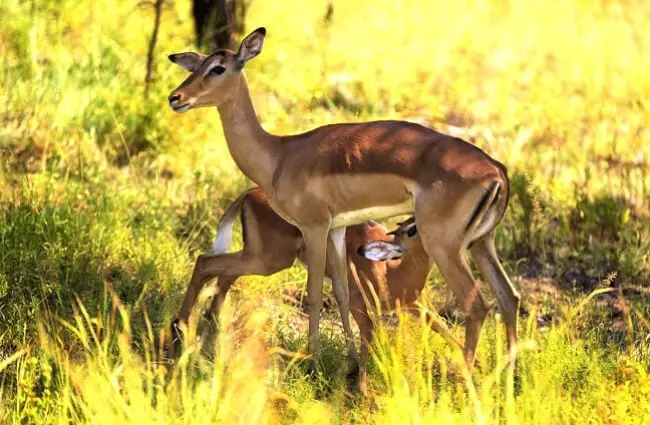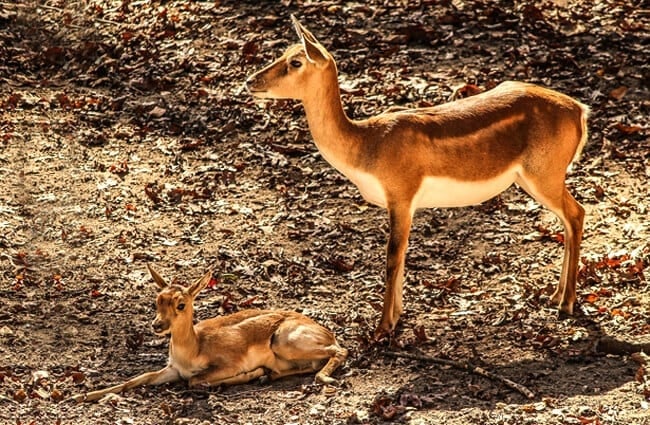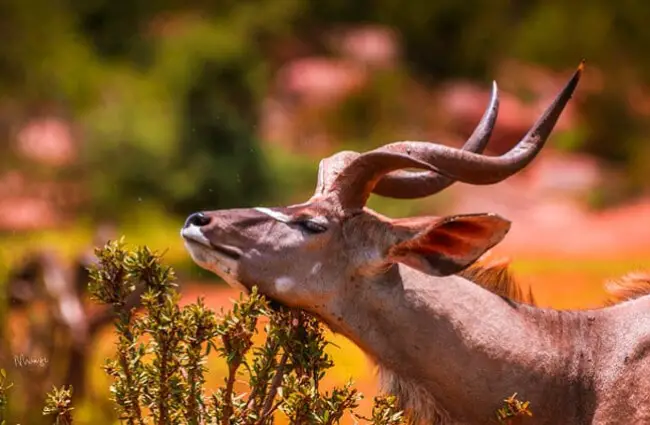Impalas are medium-sized antelopes native to Africa. They are commonly targeted as prey for a number of large African predators, including lions, cheetahs, leopards, and more. To give them the edge against skilled and powerful predators, these mammals are lithe and acrobatic. They are well-known for making dramatic, characteristic leaps into the air to confuse and evade predators. Read on to learn about the impala.
Description of the Impala
Impalas lie smack in between the extremes of antelope size. They are larger than Thomson’s gazelles, but smaller than elands. They stand up to 36 in. tall at the shoulder, and weigh up to 168 lbs. Their fur is reddish-brown, with lighter colored sides and underbelly.
Males have pairs of curved horns, while females do not grow horns at all. This easily-distinguishable difference is called sexual dimorphism. Another way to tell males from females is by looking at their size, as females are significantly smaller than males.
Interesting Facts About the Impala
Perhaps most well-known for becoming prey to the large and charismatic predators of Africa, impalas are actually surprisingly efficient at avoiding becoming dinner! Learn more about the various adaptations that help these antelopes compete.
- Hop to it! – When something as terrifying as a lion is chasing you, it can help to have a few tricks up your sleeve (or hoof). These creatures are capable of leaping nearly ten feet into the air, jumping over bushes, rocks, and other impalas. This helps them avoid predators.
- Dominance – Male impalas will fight one another for the ability to reproduce. The strongest male with the greatest endurance is more likely to win, and more likely to pass those genetics on to its offspring. This gives them a better chance of surviving.
- Learning Curve – The shape of an impala’s horns allows battling males to interlock their horns together, and throw the other animal off balance. Older and more experienced males are more likely to have perfected this battling technique.
- Sound the Alarm – Not only do impalas sound an alarm call when they spot a potential predator, but they are also capable of hearing and recognizing the alarm calls of other species. When zebras or wildebeest give their alarm calls impalas will also flee as well.
Habitat of the Impala
These antelopes prefer areas with plenty of shade, rather than open savannahs or grasslands. Their favorite habitats are woodlands, but they also commonly reside on the borders between woodlands and other habitats like savannahs.
As with any African habitat, areas closer to reliable water sources are preferred and highly valuable resources. The habitat choice usually differs between the dry season and the wet season, especially in areas with greater elephant activity and grazing, which impacts the available food.
Distribution of the Impala
Impalas exist across southeastern Africa, and parts of western South Africa. Their historic habitats are relatively similar to their range now, with a few exceptions. While they were once plentiful in Burundi, they are now entirely absent. The black-faced subspecies is also restricted to a much smaller range than they were originally, but the common subspecies is, well, common.
Diet of the Impala
These mammals employ a combination of grazing for grasses and browsing for leaves and shrubs. Basically, they eat whichever is most plentiful at the time. When grazing, they prefer softer grasses that have higher nutritional value, rather than some of the tougher grasses that may be consumed by other grazers. Herds will graze together, and individuals on the outskirts will remain much more vigilant while feeding. This helps the entire herd avoid predators.
Impala and Human Interaction
Overall, the population of this species is stable, but the black-faced subspecies is considered to be a threatened species. Researchers believe there may be less than a few thousand black-faced impalas left. Hunting of these creatures is common, as they are a sizeable prey item, and capable of feeding a number of people. Poaching of the protected subspecies is a threat to their survival, followed by habitat destruction.
Domestication
Impalas have not been domesticated in any way.
Does the Impala Make a Good Pet
No, impalas do not make good pets. They are wild antelopes, and it is illegal to own one as a pet in most places. Further, they are extremely competent jumpers, and you would likely not be able to contain them.
Impala Care
In a zoological setting, fencing must be extremely tall and sturdy to house these creatures safely. This graceful animal needs plenty of grazing area, preferably with a number of trees or structures to provide shade. Zoos feed them a formulated diet created for antelopes, with additional browse and hay to supplement their diet. They are also provided with vitamins and minerals at the discretion of the facility’s veterinarian.
Behavior of the Impala
This species is primarily diurnal, as the majority of their predators are most active at night. They primarily spend their days grazing about for food. They are social animals that live in one of three different types of groups:
- Territorial Males – accumulate females and guard them from neighboring males.
- Bachelor Herds – groups of males remain in relatively close contact. Bachelor herds of young or old males will interact peacefully, but middle-aged males mostly spar or avoid one another.
- Herds of Females – All-female herds are groups of females, commonly with calves that disperse soon after weaning.
Reproduction of the Impala
Most mating occurs in herds of territorial males, as only the strongest males can hold territories. Females within the herd will mate with the male when they are receptive. She will have a six or seven-month gestation, which results in the birth of a single calf.
For the first week of its life, the calf will hide in dense vegetation, and the mother will return periodically to feed it. Weaning occurs anywhere between four and six months old, and once weaned, the calf will join its own herd.













![Red Angus Closeup of a beautiful Red Angus cowPhoto by: U.S. Department of Agriculture [pubic domain]https://creativecommons.org/licenses/by/2.0/](https://animals.net/wp-content/uploads/2020/03/Red-Angus-4-238x178.jpg)












![Red Angus Closeup of a beautiful Red Angus cowPhoto by: U.S. Department of Agriculture [pubic domain]https://creativecommons.org/licenses/by/2.0/](https://animals.net/wp-content/uploads/2020/03/Red-Angus-4-100x75.jpg)

